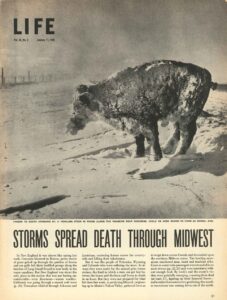
Life Magazine featuring a cow that froze during the night
During the holidays, families all over the U.S. gather to make memories and offer warm wishes and gifts in celebration of the winter holidays. As they gather, service members are often away, deployed or stationed at bases all over the world. Historically, these winter holidays have often brought difficult weather conditions to families and farms across the American West. In these moments, service members at Hill Air Force Base and other air bases have played a critical role in offering community support with “Haylift” or “Hayride” operations where Air Force bases and related agencies across the U.S. airlifted supplies to those in need.
Two instances of this type of operation in Utah included the winters of 1949 and 1967. During these winters, massive blizzards swept across multiple states, threatening lives with freezing temperatures and substantial snow drifts that isolated families and communities. Thanks to the humanitarian efforts of the U.S. Air Force, rescue teams, volunteers and community members, these winters were survivable.
The Blizzards of 1949
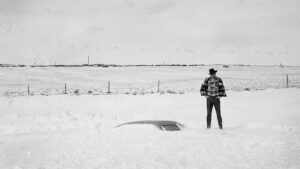
Car buried in the snow
Starting in December 1948 and lasting through January 1949, seventeen snowstorms hit the Intermountain West and Midwestern states. Over forty inches of snow fell during January alone and with wind speeds around 55 mph (the highest recorded at 73 mph), snow drifts grew to over thirty feet tall. With strong winds and unprecedented snow accumulation, cars, roads, train tracks and even houses were buried.
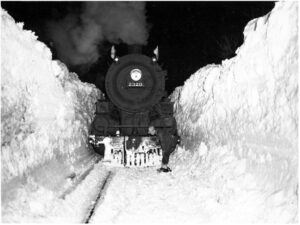
Train with snowbanks in Nebraska
Stranded train passengers, families and livestock struggled to survive2. An estimated one million cows and sheep were trapped in freezing conditions across the Midwest in remote areas1. After the largest blizzard hit on January 2 and 3, the National Weather Service reported forty deaths in four states5. The nation became aware that this was clearly a life-or-death situation for countless people and livestock.
Rescue Operations
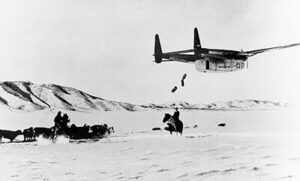
C-119 dropping bales of hay to cattle
Starting on January 3, the 2151st Rescue Unit at Lowry Air Force Base in Colorado began airdropping food, medicine and supplies to stranded people and livestock across Colorado, Wyoming and Nebraska. The group flew different aircraft including the C-47 Skytrain, B-25 Mitchell, C-82 Packet, L-5 Sentinel and Sikorsky H-5 to deliver food and blankets to stranded families at homes and passengers on blocked trains3. To those who received these supplies, it was lifesaving.
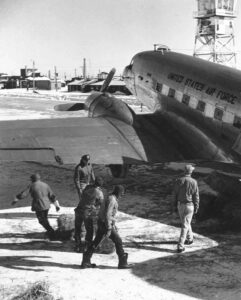
Airmen loading hay onto a C-47 at the Casper Army Base
However, there were thousands more that needed help and the 2151st Rescue Unit couldn’t do it alone. The Tenth Air Force joined the cause and began dropping food, supplies and livestock feed on January 12 and coordinated aerial relief missions in Wyoming, Kansas, Colorado, North Dakota, South Dakota and Nebraska. They called this Operation Hayride (later known as Operation Haylift), as they would drop bales of hay and feed from aircraft to livestock and wild deer populations remotely stranded. Later, the 62nd Troop Carrier Wing of the Fourth Air Force, the 316th Troop Carrier Wing of the Ninth Air Force and the 2473rd Air Force Reserve Training Center would join the humanitarian efforts3. In Utah, the Air National Guard flew hay out of Salt Lake City to millions of livestock on the snow-encrusted wastes of western Utah and eastern Nevada. Hill Air Force Base also aided in bringing feed to inaccessible areas of the state for deer populations in order to avoid starvation among wildlife6.
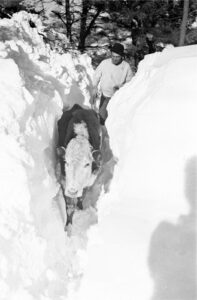
Cow freed from a snow drift
The C-47 Skytrain could carry a payload of 2.5 tons and the C-82 Packet could carry a payload of 4.5 tons. Each aircraft had its usual crew with an additional “spotter,” a civilian who would guide the servicemen to local ranches and farms, and a “kicker” who pushed the hay or supplies outside the cargo doors8. Harold Harvell, a participant in Operation Haylift, reflected on one of the many aerial drops he assisted:
Flying on many of the hay drops, I can remember some of the detailed airborne activities. We became so proficient that a local rancher flying with us asked if we could drop the hay closer to his barn. On the next drop, one of the bales of hay knocked off the small porch entrance to his barn. The rancher immediately hollered “That’s closer [sic] enough!” This provided a little humor to a very serious operation!1
The Results
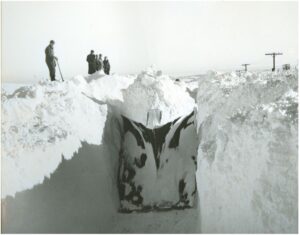
In just 33 days, thirty C-82s and twelve C-47s flew more than 660 sorties and delivered over 2,500 tons of supplies to eastern Nevada and western Utah. The Tenth Air Force dropped 2,100 tons of hay, food, medical and emergency supplies to five states in just three months. In total, more than 200 aircraft delivered 4,700 tons of supplies and evacuated 1,128 people in eight states from January to March 19493.
The Blizzards of 1967
History repeated itself in December 1967 when blizzards covered the Navajo and Hopi Indian Reservations in southern Utah, Arizona and New Mexico. Once again, snow piled high, up to ten feet, and stranded people and livestock, threatening their lives. Many Military and Tactical Airlift Wings, Military and Tactical Airlift Groups, Tactical Fighter Groups and Aerospace Rescue and Recovery Squadrons assisted in what became Operation Haylift II. Using aircraft such as the C-119 Flying Boxcar, C-124 Globemaster II, C-54 Skymaster and C-47 Skytrain, the Air Force and volunteer groups delivered 858 tons of hay, 349 tons of food and evacuated 1,361 passengers in just eleven days4. This massive effort in such a short time reduced livestock loss on the reservations to only 5%, a feat that required dedicated military men and women, volunteers and devoted communities who were willing to face freezing conditions.
Conclusion
Nothing could have prepared the American West for the storms that hit them in the winters of 1949 and 1967. Many lives and livestock were lost to the freezing temperatures and life was disrupted for a time. These struggles were drastically cut short by Operation Haylift in 1949 and Operation Haylift II in 1967. Using the skills of the Air Force, superior aircraft and the dedication of communities, the hardships of those storms were eased by acts of service and kindness. The Air Force’s list of humanitarian efforts is an astonishing list of activities, from transporting refugees to tossing hay out of cargo windows. So, while service members at Hill Air Force Base do not always get the winter holidays off, their sacrifice plays a role in continuing the safety and security of the local Utah community, and the American community, at large.
Visit Hill Aerospace Museum to learn more about many of the aircraft used in these operations. Check out the virtual tours of our C-119 Flying Boxcar, C-124 Globemaster II and C-47 Skytrain to visualize how the Air Force used these aircraft to deliver air drops of needed foods and supplies, and to picture yourself as a “kicker” or “spotter” serving those in need.
Bibliography
1. Cassinelli, Dennis. “Operation Haylift 1948-1949.” The Ely Times. February 17, 2020. https://elynews.com/2020/02/17/operation-haylift-1948-1949/.
2. Dunn, Meg. “The Blizzard of 1949, the Earliest Peoples in NoCo, and a Shoutout to our Sponsors.” Norther Colorado History. January 6, 2017. https://www.northerncoloradohistory.com/blizzard-1949-earliest-peoples-noco-shoutout-sponsors/#:~:text=Car%20buried%20in%20snow%20during%20the%20blizzard%20of,piled%20some%20drifts%20as%20high%20as%2030%20feet.
3. Haulman, Daniel L. “Operation Hayride.” Air Mobility Command Museum. Accessed November 15, 2022. https://amcmuseum.org/history/operation-hayride/.
4. Haulman, Daniel L. “Operation Haylift II.” Air Mobility Command Museum. Accessed November 15, 2022. https://amcmuseum.org/history/operation-haylift-ii/.
5. Hein, Rebecca. “The Notorious Blizzard of 1949.” WyoHistory.org. March 14, 2015. http://www.wyohistory.org/encyclopedia/notorious-blizzard-1949#:~:text=The%20blizzard%20started%20on%20Sunday%20Jan.%202%2C%201949,died%20in%20western%20South%20Dakota%2C%20Colorado%20and%20Nebraska.
6. Hilltop Times. “Air Force Joins Sportsmen to Feed Hungry Deer,” January 21, 1949, accessed December 8, 2022, https://newspapers.lib.utah.edu/details?id=23105442.
7. National Weather Service. “January, 1949 Blizzard.” Accessed November 15, 2022. https://www.weather.gov/unr/1949-01.
8. Nebraska Public Media. “Operation Haylift.” Accessed November 15, 2022. https://www.nebraskastudies.org/en/1925-1949/beef-goes-modern/operation-haylift/.
9. Salt Lake Tribune. “Haylift Drops Feed to Feeble Sheep,” January 25, 1949, accesses December 8, 2022, https://newspapers.lib.utah.edu/details?id=29012675&q=Operation+Haylift.
